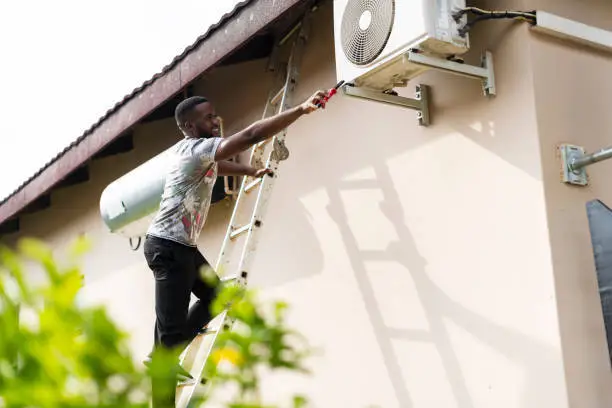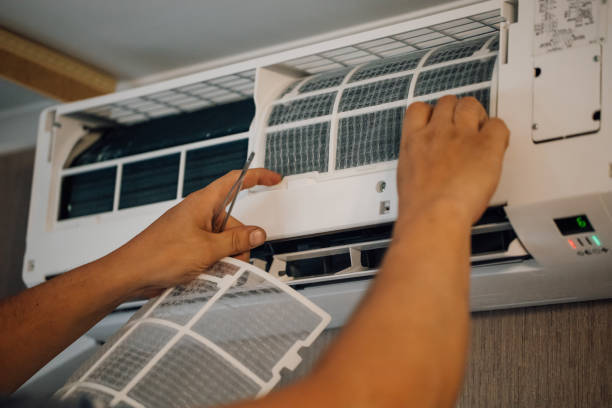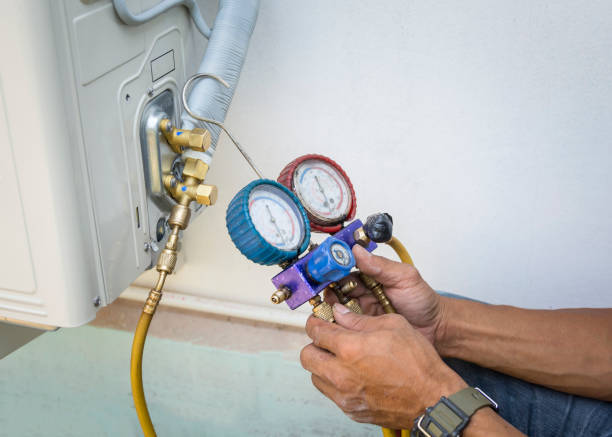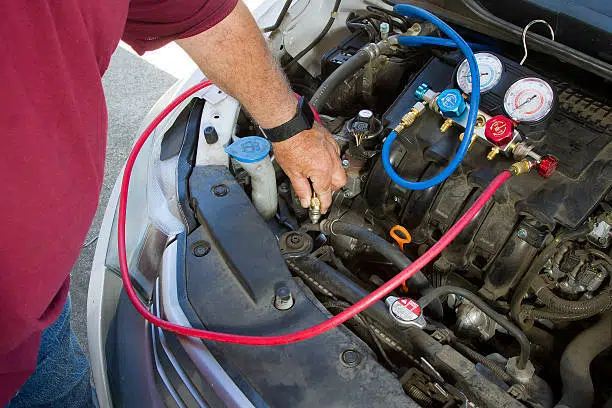
Table of Contents
As the summer sun beats down, a malfunctioning air conditioner can quickly turn your home into an uncomfortable sauna. While some AC issues may require professional intervention, many common problems can be resolved with a bit of know-how and elbow grease. In this comprehensive guide, we’ll walk you through the steps to diagnose and repair a home air conditioner, empowering you to keep your cool even on the hottest of days.
Understanding Your Air Conditioner
Before diving into repairs, it’s essential to have a thorough understanding of how your air conditioning system works. At its core, an air conditioner consists of several key components:
- Condenser Unit: This outdoor component plays a crucial role in releasing heat absorbed from inside your home. It houses the condenser coil, which contains refrigerant in a gaseous state. As outdoor air passes over the coil, the refrigerant releases heat and condenses into a liquid.
- Evaporator Coil: Located indoors, typically within your furnace or air handler, the evaporator coil absorbs heat from the air inside your home. As warm air passes over the coil, the refrigerant evaporates, absorbing heat in the process.
- Compressor: Often referred to as the “heart” of the air conditioning system, the compressor is responsible for circulating refrigerant between the indoor and outdoor units. It compresses the refrigerant gas, increasing its temperature and pressure before sending it to the condenser coil for heat release.
- Refrigerant: This chemical compound circulates through the air conditioning system, alternating between a gaseous and liquid state to facilitate heat transfer. As it absorbs heat from indoor air at the evaporator coil, it carries that heat outdoors to be released at the condenser coil.
When functioning correctly, these components work together seamlessly to extract heat from your home and expel it outside, leaving you with a cool and comfortable indoor environment. Understanding how each part contributes to the cooling process can help you with correct air conditioner repair.
The Most Common AC Problems You Should Know About
Even the most reliable air conditioning systems can encounter issues from time to time. Here are some of the most common problems homeowners may face:
Poor Airflow
If your air conditioner isn’t circulating air as effectively as it should, it could be due to several factors:
- Clogged Air Filter: Over time, dust and debris can accumulate in the air filter, restricting airflow. Regularly replacing or cleaning the filter can improve airflow and prevent strain on the system.
- Blocked Vents: Ensure all vents throughout your home are open and unobstructed to allow for proper airflow. Furniture, curtains, or other objects blocking vents can hinder air circulation.
- Malfunctioning Blower Motor: The blower motor is responsible for pushing conditioned air through the ductwork and into your home. If the motor is malfunctioning, airflow may be weak or inconsistent. A professional technician can diagnose and repair issues with the blower motor.
Check out how to clean your air filters with ease in our previous guide via the link below.
https://thehvacservice.ca/6-simple-steps-to-clean-your-air-conditioner-filter/
Warm Air Blowing from Vents
If you notice warm air coming from your vents when your air conditioner is running, it could indicate various issues:
- Refrigerant Leak: Low refrigerant levels due to a leak can prevent the air conditioner from effectively cooling the air. A qualified technician can locate and repair the leak and recharge the system with refrigerant.
- Compressor Problems: The compressor is responsible for pressurizing refrigerant and facilitating heat exchange. Issues with the compressor, such as failure or inefficiency, can result in warm air blowing from the vents.
- Evaporator Coil Issues: Damage or dirt buildup on the evaporator coil can hinder the absorption of heat from indoor air, leading to inadequate cooling. Regular maintenance, such as coil cleaning, can help prevent this problem.
Strange Noises
Unusual sounds emanating from your air conditioner may indicate underlying issues:
- Loose Components: Vibrations from normal operation can loosen screws, bolts, or other components, resulting in rattling or clanking noises. Tightening or replacing these components can resolve the issue.
- Worn-Out Belts: Over time, the belts that connect various components of the air conditioner may become worn or misaligned, causing squealing or squeaking noises. Replacing the belts can eliminate the noise.
- Motor Issues: Problems with the blower motor or fan motor, such as worn bearings or damaged blades, can produce banging or humming noises. Inspection and repair by a professional technician are recommended to address motor issues.
Leakage or Moisture
Any signs of moisture or leaks around your air conditioner could indicate various issues:
- Refrigerant Leak: Refrigerant leaks can pose health and environmental risks and should be addressed promptly by a qualified technician.
- Blocked Drain Line: Over time, the drain line can become clogged with algae, mold, or debris, preventing proper drainage of condensate. Flushing the drain line or clearing blockages can resolve this issue.
- Condensation Issues: Excessive condensation around the air conditioner may indicate poor insulation or ventilation in the ductwork, leading to moisture buildup. Addressing insulation or ventilation deficiencies can help prevent condensation-related problems.
Thermostat Problems
If your thermostat isn’t functioning properly, it could lead to various issues:
- Inaccurate Temperature Readings: A faulty thermostat may provide inaccurate temperature readings, causing the air conditioner to run excessively or insufficiently. Calibrating or replacing the thermostat can resolve this issue.
- Inability to Control the AC: Malfunctioning thermostats may fail to communicate with the air conditioner, preventing proper control of temperature settings. Checking wiring connections and replacing the thermostat if necessary can restore functionality.
Find out how much air capacitor replacement costs in our previous article.
However, for complex issues or those requiring specialized expertise, it’s always wise to seek professional assistance. Our team at HVAC Service Solutions is here to help. With years of experience and a commitment to customer satisfaction, we specialize in diagnosing and resolving a wide range of air conditioning problems.
You can contact us for professional air conditioner repair in Canada via the link below.
DIY Troubleshooting: How to Repair a Home Air Conditioner

Now that you’re familiar with some common AC problems, let’s dive into detailed steps you can take to troubleshoot and diagnose these issues on your own:
Check Air Filters
Start by inspecting and replacing your air filters if they’re dirty or clogged. Restricted airflow due to dirty filters can put strain on your AC system and reduce its efficiency.
- Locate the air filter panel on your HVAC system. This is typically found near the return air duct or furnace.
- Remove the panel and carefully slide out the air filter.
- Inspect the filter for dirt, dust, and debris. If it appears dirty or clogged, it’s time for a replacement.
- Choose a replacement filter that matches the size and type specified by your HVAC system’s manufacturer.
- Insert the new filter into the filter slot, making sure it’s positioned correctly.
- Secure the filter panel back in place, ensuring it’s tightly sealed to prevent air leaks.
Inspect Vents and Ducts
Make sure all vents are open and unobstructed to allow for proper airflow. Additionally, check ducts for any signs of blockages or leaks that may be hindering air circulation.
- Walk through your home and check each vent to ensure it’s fully open and free from blockages. Remove any furniture, curtains, or other objects obstructing airflow.
- Use a flashlight to inspect visible sections of ductwork for signs of damage, such as holes, tears, or disconnected joints.
- Pay special attention to ducts located in attics, crawl spaces, or other hard-to-reach areas where leaks or damage may occur.
- Seal any visible leaks or gaps in the ductwork using foil tape or mastic sealant. For larger repairs, consider contacting a professional ductwork specialist.
At HVAC Service Solutions, we pride ourselves on offering top-notch installation and professional maintenance services throughout Canada. Our team of trained technicians ensures proper placement and configuration of your new AC unit, adhering strictly to manufacturer specifications. By optimizing performance and efficiency during installation, we minimize the risk of future issues, providing you with peace of mind.
Test the Thermostat
Verify that your thermostat is set to the correct temperature and is functioning properly. If necessary, replace batteries and recalibrate the thermostat to ensure accurate temperature readings.
- Check the thermostat display to ensure it’s powered on and displaying the correct time and temperature settings.
- If the thermostat operates on batteries, replace them with fresh ones to ensure reliable operation.
- Use a separate thermometer to verify the accuracy of the thermostat’s temperature readings. If there’s a discrepancy, recalibrate the thermostat according to the manufacturer’s instructions.
- Test the thermostat by adjusting the temperature settings and ensuring the air conditioner responds accordingly. If the system fails to turn on or off as expected, further troubleshooting may be necessary.
Clean the Condenser Unit
Outdoor condenser units can accumulate dirt, debris, and vegetation over time, obstructing airflow and reducing efficiency. Use a garden hose to gently clean the condenser coils and remove any debris from the surrounding area.
- Turn off power to the condenser unit at the disconnect switch or circuit breaker to prevent electrical shock.
- Remove any leaves, grass clippings, or other debris from the exterior of the condenser unit using a brush or vacuum cleaner.
- Carefully spray water from a garden hose onto the condenser coils to remove dirt and debris. Start from the top and work your way down to ensure thorough cleaning.
- Avoid using high-pressure water or harsh cleaning chemicals, as these can damage the coils and fins.
- Trim back any vegetation or foliage around the condenser unit to ensure adequate airflow and ventilation.
Inspect Refrigerant Levels
If you suspect a refrigerant leak, it’s best to leave this task to a professional. However, you can check for signs of ice buildup on the evaporator coil, which may indicate low refrigerant levels.
- Locate the indoor evaporator coil, typically housed within the air handler or furnace.
- Inspect the coil for any signs of ice buildup or frost accumulation. If you notice ice forming on the coil, it may indicate a refrigerant leak or inadequate airflow.
- Turn off the air conditioner and allow the ice to thaw completely before attempting any further diagnosis or repair.
- Contact a qualified HVAC technician to perform a thorough inspection and leak detection test. They can safely handle refrigerant-related issues and recharge the system if necessary.
By following these detailed steps, you can confidently troubleshoot common AC problems and take proactive measures to keep your air conditioning system running smoothly.
Tools and Materials for DIY Air Conditioner Repair

To perform DIY AC repairs effectively, it’s essential to have the right tools and materials on hand. Here’s a detailed list of what you’ll need:
- Screwdrivers: A set of screwdrivers with various sizes and types (flathead, Phillips, etc.) will be invaluable for removing screws and accessing different components of your air conditioner. Make sure to have both handheld and power screwdrivers for convenience.
- Wrenches: Adjustable wrenches or socket wrench sets will be necessary for loosening or tightening bolts, nuts, and fittings. Opt for wrenches of different sizes to accommodate various components of your AC system.
- Vacuum Cleaner: A vacuum cleaner equipped with a brush attachment will help you remove dust, dirt, and debris from the interior and exterior of your air conditioner. Regular vacuuming can prevent airflow restrictions and maintain optimal system performance.
- Replacement Air Filters: Stock up on replacement air filters that are compatible with your specific air conditioning unit. Choose high-quality filters with the appropriate MERV (Minimum Efficiency Reporting Value) rating to ensure efficient air filtration and system protection.
- Refrigerant Recharge Kit (if applicable): If you suspect low refrigerant levels or need to recharge your AC system, a refrigerant recharge kit may be necessary. However, handling refrigerant requires expertise and may be best left to trained professionals. If you’re unsure, consult with an HVAC technician before attempting to recharge your system.
Ensure you have these items readily available before starting any repair work. Having the right tools and materials on hand will streamline the repair process and help you address common AC issues effectively.
Safety Precautions
Safety should always be a top priority when working on your air conditioner to prevent accidents and injuries. Before beginning any repairs, follow these essential safety precautions:
- Turn off Power: Before starting any repair work, turn off power to the air conditioning unit at the circuit breaker or main electrical panel. This will prevent the risk of electric shock or injury while working on the system.
- Wear Protective Gear: Always wear appropriate protective gear, such as gloves and safety glasses, to shield your hands and eyes from potential hazards. Additionally, consider wearing long sleeves and pants to protect your skin from sharp edges or debris.
- Exercise Caution with Electrical Components: When working with electrical components, handle them with care and avoid touching exposed wires or terminals. Use insulated tools and ensure they’re rated for the voltage of your AC system to prevent electrical accidents.
- Be Cautious with Refrigerants: If handling refrigerant, follow all safety guidelines and regulations outlined by the Environmental Protection Agency (EPA). Refrigerants can be hazardous to your health and the environment, so exercise caution and avoid inhalation or skin contact.
By adhering to these safety precautions, you can minimize the risk of accidents and injuries while performing DIY AC repairs. If you’re unsure about any aspect of the repair process or encounter unexpected challenges, don’t hesitate to seek professional assistance.
When to Call a Professional
While DIY air conditioner repair can address many common issues, certain situations require the expertise of a professional HVAC technician. Electrical issues or wiring problems pose significant safety risks and should be handled by a trained professional to prevent accidents or damage to your system. Similarly, major component failures, such as a faulty compressor, often necessitate specialized knowledge and equipment to diagnose and repair effectively. Additionally, refrigerant leaks or recharge needs require handling of potentially hazardous substances and should be addressed by a qualified technician to ensure proper containment and disposal.
Attempting to tackle these complex issues without the necessary expertise can exacerbate problems and lead to costly repairs or safety hazards. Our professional HVAC services at HVAC Service Solutions are equipped to handle a wide range of AC issues with precision and care. With our experienced technicians and commitment to customer satisfaction, you can trust us to diagnose and resolve any air conditioning problems efficiently and effectively. Contact us today for expert AC repair services in Canada.
Conclusion
Mastering air conditioner repair empowers you to tackle common issues confidently. While DIY troubleshooting can solve many problems, complex issues require professional expertise to ensure safety and effectiveness. Don’t let air conditioning problems disrupt your comfort. Contact HVAC Service Solutions today for prompt and reliable AC repairs
Frequent Asked Questions
What are the signs that my air conditioner needs repair?
Signs that your air conditioner may need repair include various symptoms indicating suboptimal performance. Poor airflow, for instance, could suggest a clogged air filter restricting the system’s efficiency. If you notice warm air blowing from the vents despite setting the temperature to cool, it might indicate underlying issues such as a refrigerant leak, compressor malfunction, or problems with the evaporator coil. Strange noises emanating from the AC unit, such as clanking, banging, or squealing, may signify loose components, worn-out belts, or motor dysfunction.
Additionally, any signs of moisture or leakage around the air conditioner warrant immediate attention, as they could indicate problems like a refrigerant leak, blocked drain line, or condensation issues. Moreover, if your thermostat isn’t functioning properly, resulting in inaccurate temperature readings or an inability to control the air conditioner effectively, it’s a clear indication that there might be issues with the thermostat itself or its connection to the AC unit.
Can I troubleshoot and repair my air conditioner on my own?
While many common AC problems can be addressed through DIY troubleshooting and repairs, it’s essential to assess the complexity of the issue and your level of expertise before attempting repairs. Basic tasks such as checking and replacing air filters, inspecting and clearing vents and ducts, testing and recalibrating the thermostat, and cleaning the condenser unit can often be handled by homeowners. However, when dealing with more complex issues such as electrical problems, major component failures, or refrigerant-related issues, it’s advisable to seek professional assistance. Attempting to tackle these complex issues without the necessary expertise could lead to further damage or safety hazards.
When should I call a professional HVAC technician for AC repair?
Calling a professional HVAC technician for AC repair is advisable in several scenarios. If you encounter electrical issues or wiring problems, it’s crucial to seek professional assistance to ensure safety and prevent further damage to your system. Similarly, major component failures such as a faulty compressor require specialized knowledge and equipment to diagnose and repair effectively. Refrigerant leaks or recharge needs also necessitate professional attention to ensure proper containment, handling, and disposal of refrigerant. Attempting to address these complex issues without the necessary expertise could exacerbate problems and lead to costly repairs or safety hazards.
How often should I replace my air filters?
Air filters play a crucial role in maintaining the efficiency and performance of your air conditioner by trapping dust, dirt, and other particles from circulating in your home. The frequency of air filter replacement depends on several factors, including the type of filter, the level of air pollution in your area, and the usage of your HVAC system. As a general guideline, air filters should typically be replaced every 1 to 3 months. However, if you have pets, allergies, or live in a dusty environment, you may need to replace your filters more frequently to ensure optimal performance.
What can cause warm air to blow from my AC vents?
Warm air blowing from your air conditioner vents can be indicative of various underlying issues affecting the system’s cooling performance. One common cause is a refrigerant leak, which can disrupt the heat exchange process and prevent the air conditioner from effectively cooling the air. Additionally, compressor problems, such as failure or inefficiency, can result in inadequate cooling and the circulation of warm air. Issues with the evaporator coil, such as damage or dirt buildup, can also hinder the absorption of heat from indoor air, leading to the discharge of warm air from the vents. It’s essential to address these issues promptly to restore proper cooling and prevent further damage to your air conditioning system.
Why is my air conditioner making strange noises?
Unusual noises coming from your air conditioner can be indicative of underlying issues that require attention. Clanking, banging, or squealing noises may result from loose components, such as screws or bolts, vibrating against the unit’s housing during operation. Worn-out belts connecting various components of the air conditioner can also produce squealing or squeaking noises as they deteriorate over time. Additionally, motor issues, such as worn bearings or damaged fan blades, can cause banging or humming noises during operation. Ignoring these strange noises can lead to further damage to your air conditioner and may result in costly repairs down the line. Therefore, it’s essential to address any unusual sounds coming from your AC unit promptly to prevent more significant issues from developing.
How can I maintain my outdoor condenser unit?
Proper maintenance of your outdoor condenser unit is essential to ensure optimal performance and longevity of your air conditioning system. Regular maintenance tasks include cleaning the condenser coils, removing debris from the surrounding area, and trimming vegetation to ensure adequate airflow. Start by turning off power to the condenser unit at the circuit breaker to prevent electrical shock. Then, carefully remove any leaves, grass clippings, or other debris from the exterior of the unit using a brush or vacuum cleaner. Next, use a garden hose to gently spray water onto the condenser coils to remove dirt and debris. Be sure to start from the top and work your way down to ensure thorough cleaning. Finally, trim back any vegetation or foliage around the condenser unit to ensure proper airflow and ventilation. By performing these maintenance tasks regularly, you can help extend the life of your air conditioning system and ensure efficient operation during the hot summer months.
What should I do if I notice moisture or leaks around my air conditioner?
Moisture or leaks around your air conditioner can indicate underlying issues that require prompt attention to prevent further damage to your system. One common cause of moisture or leaks is a refrigerant leak, which can pose health and environmental risks and should be addressed immediately by a qualified HVAC technician. Another possible cause is a blocked drain line, which can result in water backing up and leaking around the unit. In some cases, condensation issues due to poor insulation or ventilation in the ductwork can also lead to moisture buildup around the air conditioner. Regardless of the cause, it’s essential to contact a professional HVAC technician to diagnose and repair the issue promptly. Attempting to address moisture or leaks without the necessary expertise can result in further damage to your air conditioning system and may compromise its performance and efficiency.
How can I ensure my thermostat is functioning properly?
Proper functioning of your thermostat is essential for maintaining a comfortable indoor temperature and maximizing energy efficiency. To ensure your thermostat is functioning correctly, start by verifying that it is set to the correct temperature and mode (cooling or heating). If your thermostat operates on batteries, replace them with fresh ones to ensure reliable operation. Next, use a separate thermometer to verify the accuracy of the thermostat’s temperature readings. If there’s a discrepancy between the thermostat’s reading and the separate thermometer, recalibrate the thermostat according to the manufacturer’s instructions to ensure accurate temperature control. Additionally, test the thermostat by adjusting the temperature settings and observing how the air conditioner responds. If you encounter any issues or notice inconsistencies in temperature control, contact a professional HVAC technician to inspect and repair the thermostat as needed. Ignoring thermostat problems can lead to discomfort, energy waste, and unnecessary wear and tear on your air conditioning system, so it’s essential to address them promptly.
Is it safe to handle refrigerant for AC repairs?
Handling refrigerant is not only complicated but also potentially hazardous to your health and the environment. Refrigerants are chemicals that can cause skin irritation, respiratory problems, and even frostbite upon contact. Additionally, many refrigerants are classified as ozone-depleting substances (ODS) or greenhouse gases, contributing to environmental pollution and climate change. Due to these risks, handling refrigerant should be left to trained professionals with the necessary equipment, expertise, and certifications to ensure safety and compliance with environmental regulations.
If you suspect a refrigerant leak or need to recharge your air conditioning system, contact a qualified HVAC technician to diagnose and address the issue safely and effectively. Attempting to handle refrigerant without the proper training and equipment can result in personal injury, environmental damage, and legal consequences, so it’s essential to leave this task to the professionals. By entrusting refrigerant-related repairs to qualified technicians, you can ensure the safety of yourself, your family, and the environment while maintaining the optimal performance and efficiency of your air conditioning system.
Share



















